Managing Human Capital: HRM Practices and Performance Analysis
VerifiedAdded on 2023/04/20
|20
|5386
|102
Report
AI Summary
This report provides a comprehensive analysis of Human Resource Management (HRM) practices and their impact on organizational performance, using Tesco as a case study. It begins with an introduction to HRM, human capital management, and personnel management, highlighting their interconnectedness. The report reviews literature on the positive effects of HRM on organizational performance, including employee motivation, skill enhancement, and financial returns. It then examines Tesco's HRM practices, focusing on issues such as unequal pay and age discrimination, and analyzes these issues using HRM models like the Hard/Soft Model and the Harvard Model. The report concludes with recommendations for improving Tesco's HRM practices to enhance employee satisfaction and organizational performance, emphasizing the importance of strategic HRM, fair compensation, and employee well-being. Desklib provides this student contributed assignment along with other study resources.

Managing Human Capital and Leadership
Paraphrase This Document
Need a fresh take? Get an instant paraphrase of this document with our AI Paraphraser
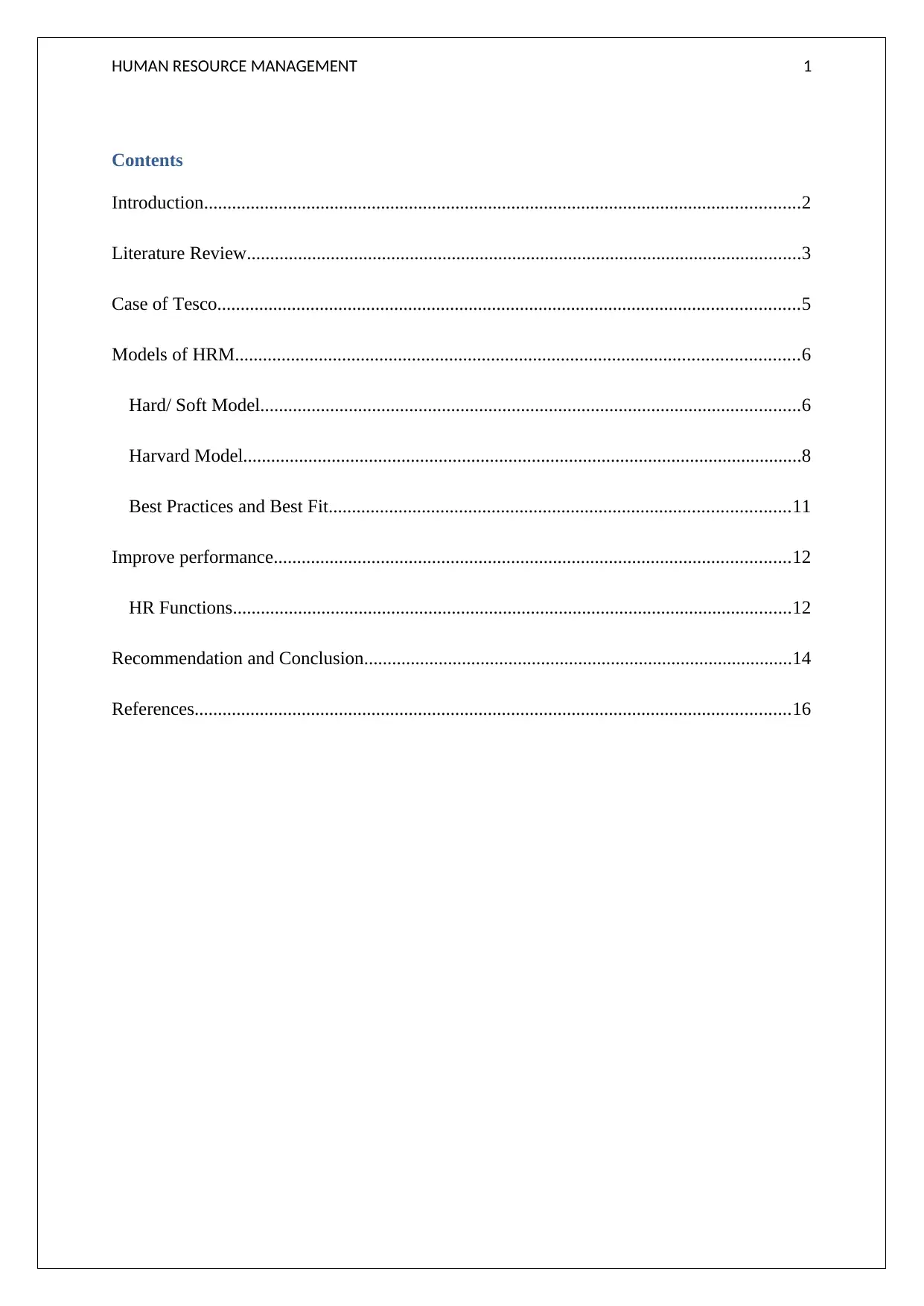
HUMAN RESOURCE MANAGEMENT 1
Contents
Introduction................................................................................................................................2
Literature Review.......................................................................................................................3
Case of Tesco.............................................................................................................................5
Models of HRM.........................................................................................................................6
Hard/ Soft Model....................................................................................................................6
Harvard Model........................................................................................................................8
Best Practices and Best Fit...................................................................................................11
Improve performance...............................................................................................................12
HR Functions........................................................................................................................12
Recommendation and Conclusion............................................................................................14
References................................................................................................................................16
Contents
Introduction................................................................................................................................2
Literature Review.......................................................................................................................3
Case of Tesco.............................................................................................................................5
Models of HRM.........................................................................................................................6
Hard/ Soft Model....................................................................................................................6
Harvard Model........................................................................................................................8
Best Practices and Best Fit...................................................................................................11
Improve performance...............................................................................................................12
HR Functions........................................................................................................................12
Recommendation and Conclusion............................................................................................14
References................................................................................................................................16
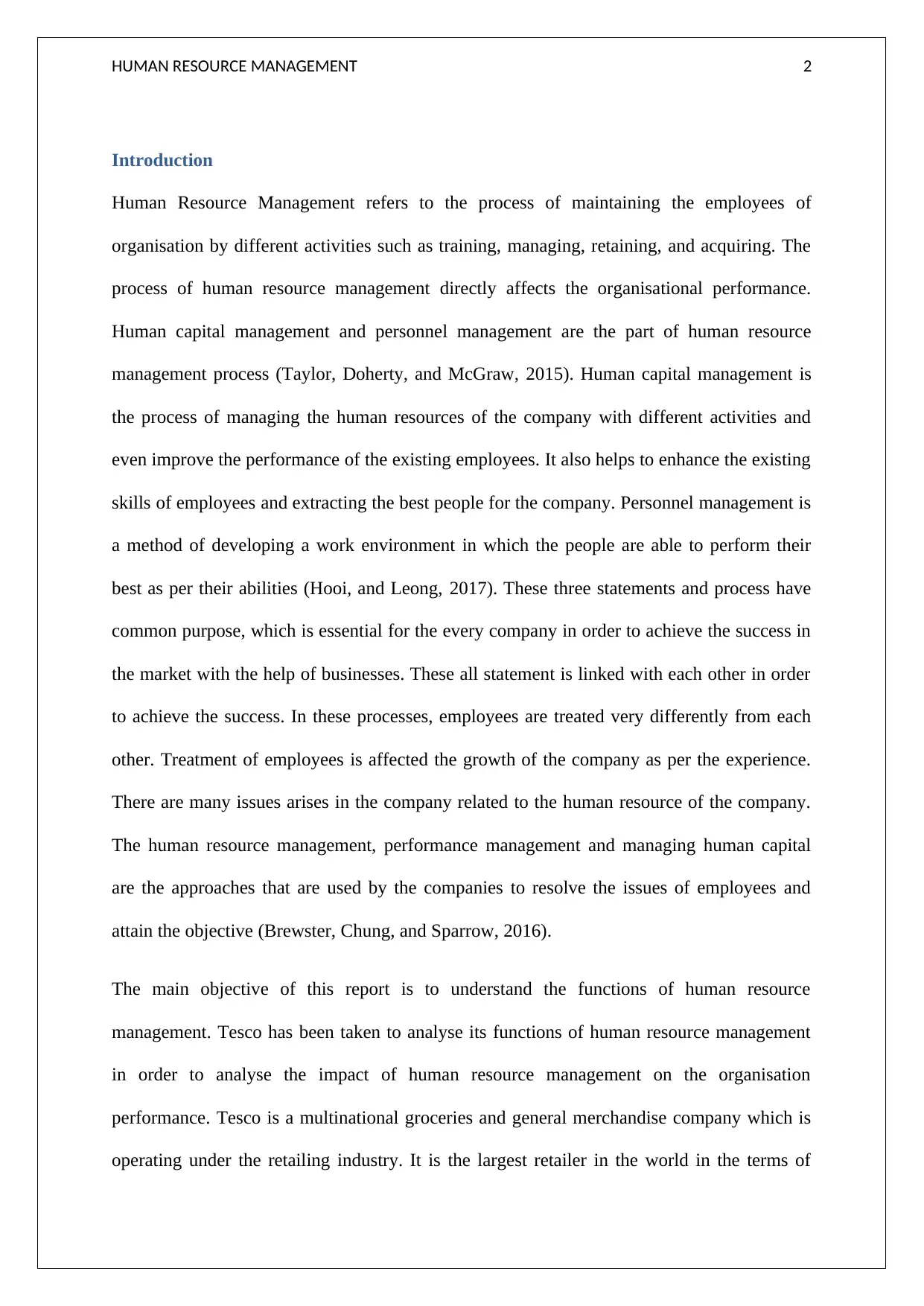
HUMAN RESOURCE MANAGEMENT 2
Introduction
Human Resource Management refers to the process of maintaining the employees of
organisation by different activities such as training, managing, retaining, and acquiring. The
process of human resource management directly affects the organisational performance.
Human capital management and personnel management are the part of human resource
management process (Taylor, Doherty, and McGraw, 2015). Human capital management is
the process of managing the human resources of the company with different activities and
even improve the performance of the existing employees. It also helps to enhance the existing
skills of employees and extracting the best people for the company. Personnel management is
a method of developing a work environment in which the people are able to perform their
best as per their abilities (Hooi, and Leong, 2017). These three statements and process have
common purpose, which is essential for the every company in order to achieve the success in
the market with the help of businesses. These all statement is linked with each other in order
to achieve the success. In these processes, employees are treated very differently from each
other. Treatment of employees is affected the growth of the company as per the experience.
There are many issues arises in the company related to the human resource of the company.
The human resource management, performance management and managing human capital
are the approaches that are used by the companies to resolve the issues of employees and
attain the objective (Brewster, Chung, and Sparrow, 2016).
The main objective of this report is to understand the functions of human resource
management. Tesco has been taken to analyse its functions of human resource management
in order to analyse the impact of human resource management on the organisation
performance. Tesco is a multinational groceries and general merchandise company which is
operating under the retailing industry. It is the largest retailer in the world in the terms of
Introduction
Human Resource Management refers to the process of maintaining the employees of
organisation by different activities such as training, managing, retaining, and acquiring. The
process of human resource management directly affects the organisational performance.
Human capital management and personnel management are the part of human resource
management process (Taylor, Doherty, and McGraw, 2015). Human capital management is
the process of managing the human resources of the company with different activities and
even improve the performance of the existing employees. It also helps to enhance the existing
skills of employees and extracting the best people for the company. Personnel management is
a method of developing a work environment in which the people are able to perform their
best as per their abilities (Hooi, and Leong, 2017). These three statements and process have
common purpose, which is essential for the every company in order to achieve the success in
the market with the help of businesses. These all statement is linked with each other in order
to achieve the success. In these processes, employees are treated very differently from each
other. Treatment of employees is affected the growth of the company as per the experience.
There are many issues arises in the company related to the human resource of the company.
The human resource management, performance management and managing human capital
are the approaches that are used by the companies to resolve the issues of employees and
attain the objective (Brewster, Chung, and Sparrow, 2016).
The main objective of this report is to understand the functions of human resource
management. Tesco has been taken to analyse its functions of human resource management
in order to analyse the impact of human resource management on the organisation
performance. Tesco is a multinational groceries and general merchandise company which is
operating under the retailing industry. It is the largest retailer in the world in the terms of
⊘ This is a preview!⊘
Do you want full access?
Subscribe today to unlock all pages.

Trusted by 1+ million students worldwide
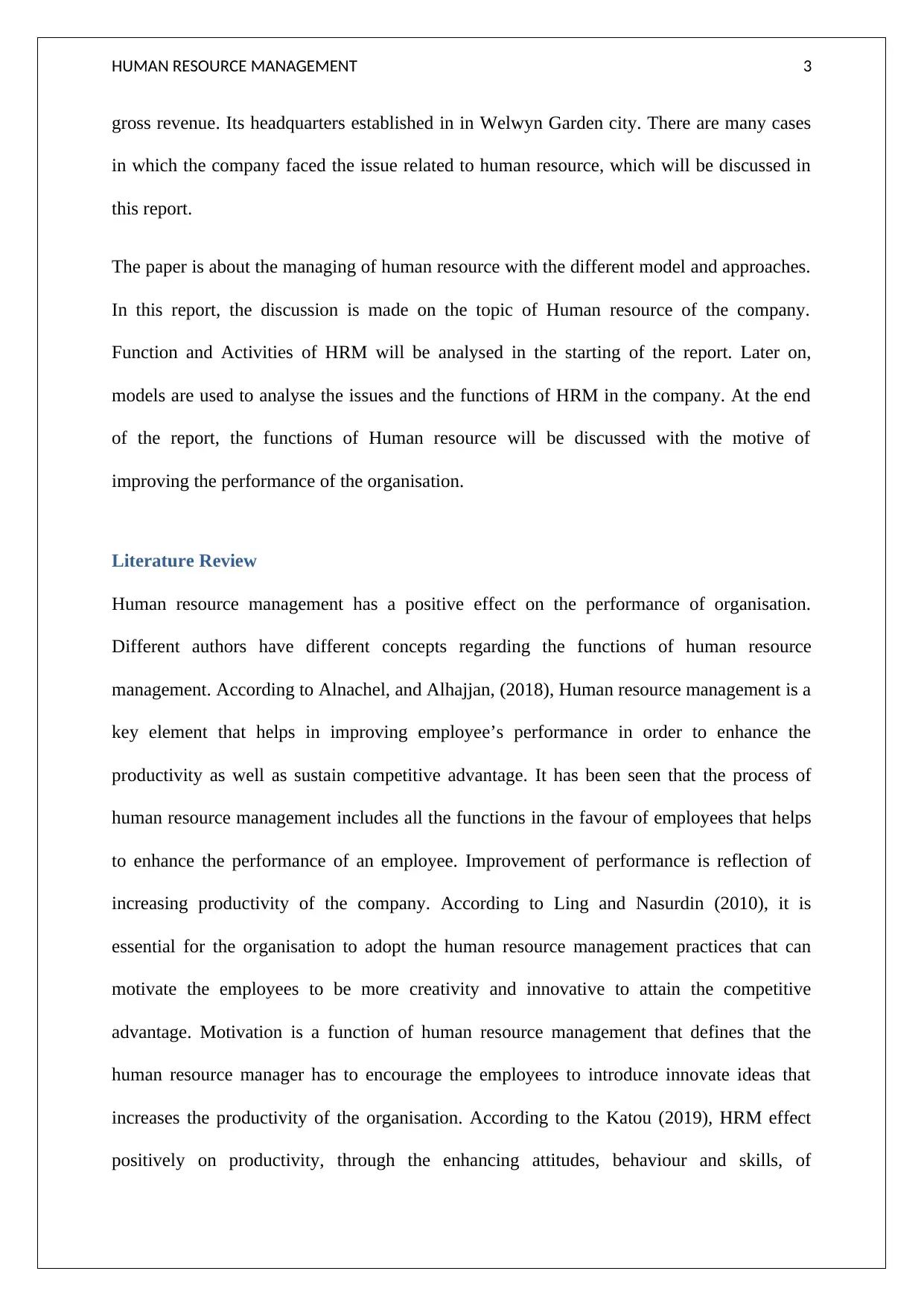
HUMAN RESOURCE MANAGEMENT 3
gross revenue. Its headquarters established in in Welwyn Garden city. There are many cases
in which the company faced the issue related to human resource, which will be discussed in
this report.
The paper is about the managing of human resource with the different model and approaches.
In this report, the discussion is made on the topic of Human resource of the company.
Function and Activities of HRM will be analysed in the starting of the report. Later on,
models are used to analyse the issues and the functions of HRM in the company. At the end
of the report, the functions of Human resource will be discussed with the motive of
improving the performance of the organisation.
Literature Review
Human resource management has a positive effect on the performance of organisation.
Different authors have different concepts regarding the functions of human resource
management. According to Alnachel, and Alhajjan, (2018), Human resource management is a
key element that helps in improving employee’s performance in order to enhance the
productivity as well as sustain competitive advantage. It has been seen that the process of
human resource management includes all the functions in the favour of employees that helps
to enhance the performance of an employee. Improvement of performance is reflection of
increasing productivity of the company. According to Ling and Nasurdin (2010), it is
essential for the organisation to adopt the human resource management practices that can
motivate the employees to be more creativity and innovative to attain the competitive
advantage. Motivation is a function of human resource management that defines that the
human resource manager has to encourage the employees to introduce innovate ideas that
increases the productivity of the organisation. According to the Katou (2019), HRM effect
positively on productivity, through the enhancing attitudes, behaviour and skills, of
gross revenue. Its headquarters established in in Welwyn Garden city. There are many cases
in which the company faced the issue related to human resource, which will be discussed in
this report.
The paper is about the managing of human resource with the different model and approaches.
In this report, the discussion is made on the topic of Human resource of the company.
Function and Activities of HRM will be analysed in the starting of the report. Later on,
models are used to analyse the issues and the functions of HRM in the company. At the end
of the report, the functions of Human resource will be discussed with the motive of
improving the performance of the organisation.
Literature Review
Human resource management has a positive effect on the performance of organisation.
Different authors have different concepts regarding the functions of human resource
management. According to Alnachel, and Alhajjan, (2018), Human resource management is a
key element that helps in improving employee’s performance in order to enhance the
productivity as well as sustain competitive advantage. It has been seen that the process of
human resource management includes all the functions in the favour of employees that helps
to enhance the performance of an employee. Improvement of performance is reflection of
increasing productivity of the company. According to Ling and Nasurdin (2010), it is
essential for the organisation to adopt the human resource management practices that can
motivate the employees to be more creativity and innovative to attain the competitive
advantage. Motivation is a function of human resource management that defines that the
human resource manager has to encourage the employees to introduce innovate ideas that
increases the productivity of the organisation. According to the Katou (2019), HRM effect
positively on productivity, through the enhancing attitudes, behaviour and skills, of
Paraphrase This Document
Need a fresh take? Get an instant paraphrase of this document with our AI Paraphraser
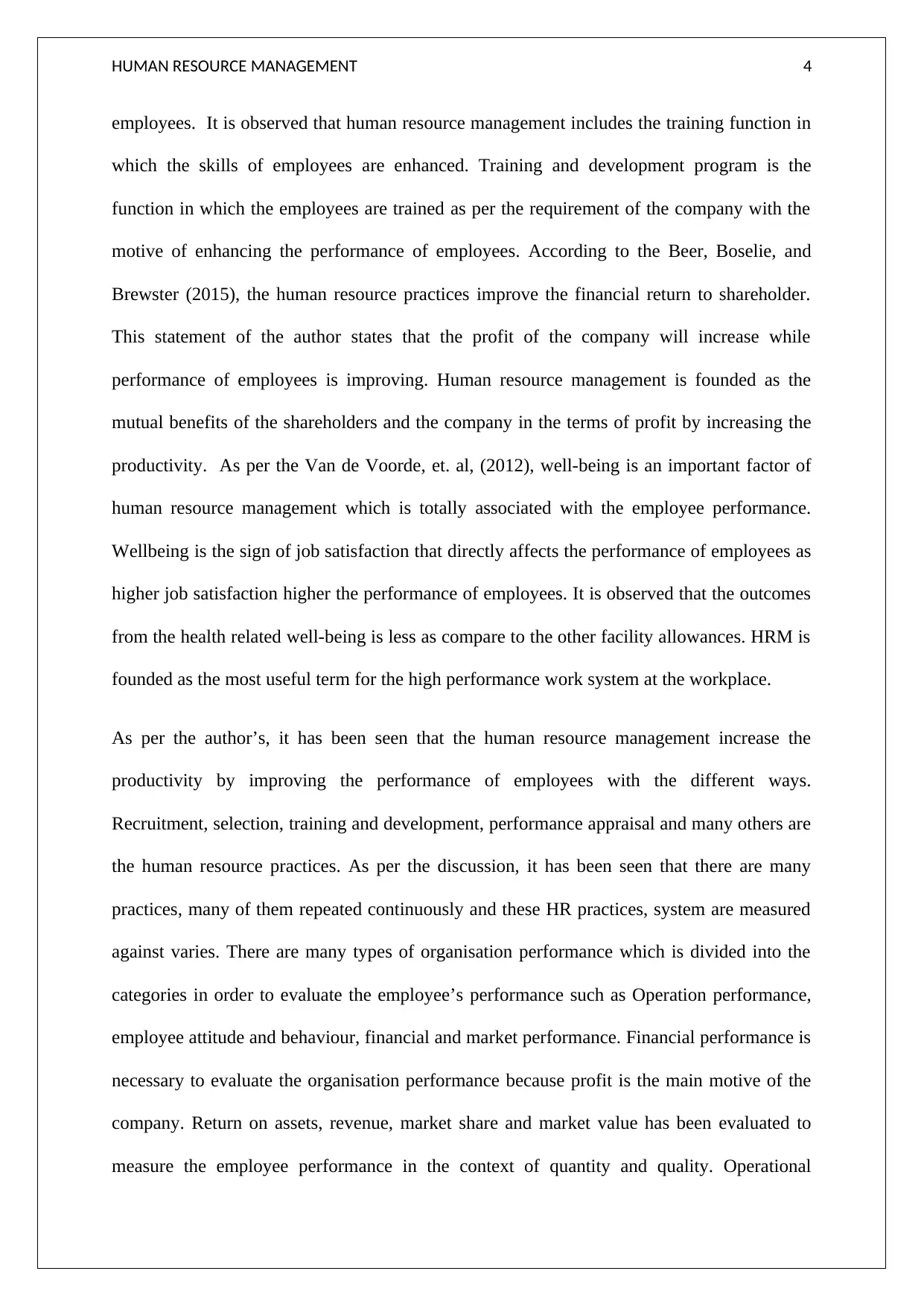
HUMAN RESOURCE MANAGEMENT 4
employees. It is observed that human resource management includes the training function in
which the skills of employees are enhanced. Training and development program is the
function in which the employees are trained as per the requirement of the company with the
motive of enhancing the performance of employees. According to the Beer, Boselie, and
Brewster (2015), the human resource practices improve the financial return to shareholder.
This statement of the author states that the profit of the company will increase while
performance of employees is improving. Human resource management is founded as the
mutual benefits of the shareholders and the company in the terms of profit by increasing the
productivity. As per the Van de Voorde, et. al, (2012), well-being is an important factor of
human resource management which is totally associated with the employee performance.
Wellbeing is the sign of job satisfaction that directly affects the performance of employees as
higher job satisfaction higher the performance of employees. It is observed that the outcomes
from the health related well-being is less as compare to the other facility allowances. HRM is
founded as the most useful term for the high performance work system at the workplace.
As per the author’s, it has been seen that the human resource management increase the
productivity by improving the performance of employees with the different ways.
Recruitment, selection, training and development, performance appraisal and many others are
the human resource practices. As per the discussion, it has been seen that there are many
practices, many of them repeated continuously and these HR practices, system are measured
against varies. There are many types of organisation performance which is divided into the
categories in order to evaluate the employee’s performance such as Operation performance,
employee attitude and behaviour, financial and market performance. Financial performance is
necessary to evaluate the organisation performance because profit is the main motive of the
company. Return on assets, revenue, market share and market value has been evaluated to
measure the employee performance in the context of quantity and quality. Operational
employees. It is observed that human resource management includes the training function in
which the skills of employees are enhanced. Training and development program is the
function in which the employees are trained as per the requirement of the company with the
motive of enhancing the performance of employees. According to the Beer, Boselie, and
Brewster (2015), the human resource practices improve the financial return to shareholder.
This statement of the author states that the profit of the company will increase while
performance of employees is improving. Human resource management is founded as the
mutual benefits of the shareholders and the company in the terms of profit by increasing the
productivity. As per the Van de Voorde, et. al, (2012), well-being is an important factor of
human resource management which is totally associated with the employee performance.
Wellbeing is the sign of job satisfaction that directly affects the performance of employees as
higher job satisfaction higher the performance of employees. It is observed that the outcomes
from the health related well-being is less as compare to the other facility allowances. HRM is
founded as the most useful term for the high performance work system at the workplace.
As per the author’s, it has been seen that the human resource management increase the
productivity by improving the performance of employees with the different ways.
Recruitment, selection, training and development, performance appraisal and many others are
the human resource practices. As per the discussion, it has been seen that there are many
practices, many of them repeated continuously and these HR practices, system are measured
against varies. There are many types of organisation performance which is divided into the
categories in order to evaluate the employee’s performance such as Operation performance,
employee attitude and behaviour, financial and market performance. Financial performance is
necessary to evaluate the organisation performance because profit is the main motive of the
company. Return on assets, revenue, market share and market value has been evaluated to
measure the employee performance in the context of quantity and quality. Operational
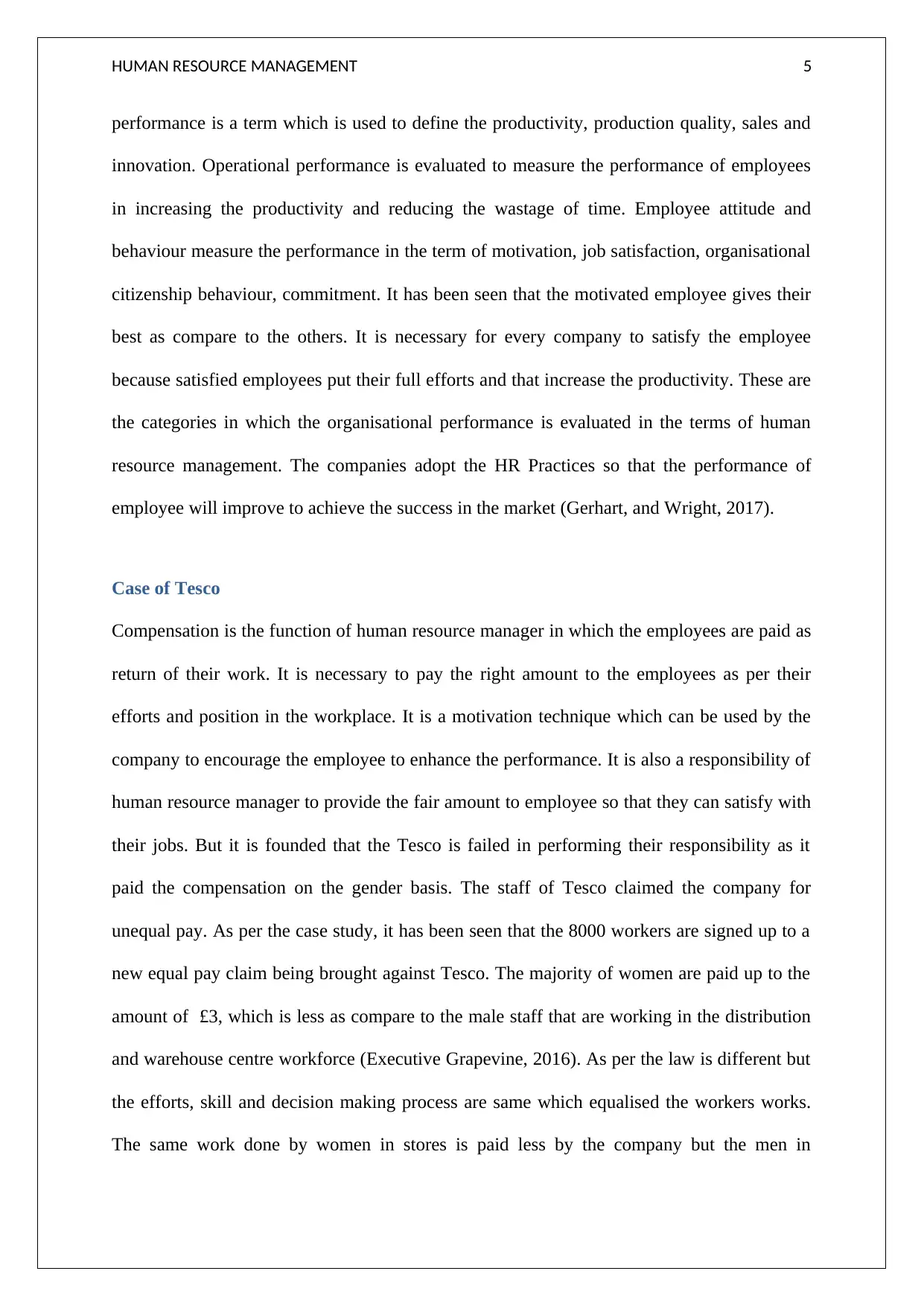
HUMAN RESOURCE MANAGEMENT 5
performance is a term which is used to define the productivity, production quality, sales and
innovation. Operational performance is evaluated to measure the performance of employees
in increasing the productivity and reducing the wastage of time. Employee attitude and
behaviour measure the performance in the term of motivation, job satisfaction, organisational
citizenship behaviour, commitment. It has been seen that the motivated employee gives their
best as compare to the others. It is necessary for every company to satisfy the employee
because satisfied employees put their full efforts and that increase the productivity. These are
the categories in which the organisational performance is evaluated in the terms of human
resource management. The companies adopt the HR Practices so that the performance of
employee will improve to achieve the success in the market (Gerhart, and Wright, 2017).
Case of Tesco
Compensation is the function of human resource manager in which the employees are paid as
return of their work. It is necessary to pay the right amount to the employees as per their
efforts and position in the workplace. It is a motivation technique which can be used by the
company to encourage the employee to enhance the performance. It is also a responsibility of
human resource manager to provide the fair amount to employee so that they can satisfy with
their jobs. But it is founded that the Tesco is failed in performing their responsibility as it
paid the compensation on the gender basis. The staff of Tesco claimed the company for
unequal pay. As per the case study, it has been seen that the 8000 workers are signed up to a
new equal pay claim being brought against Tesco. The majority of women are paid up to the
amount of £3, which is less as compare to the male staff that are working in the distribution
and warehouse centre workforce (Executive Grapevine, 2016). As per the law is different but
the efforts, skill and decision making process are same which equalised the workers works.
The same work done by women in stores is paid less by the company but the men in
performance is a term which is used to define the productivity, production quality, sales and
innovation. Operational performance is evaluated to measure the performance of employees
in increasing the productivity and reducing the wastage of time. Employee attitude and
behaviour measure the performance in the term of motivation, job satisfaction, organisational
citizenship behaviour, commitment. It has been seen that the motivated employee gives their
best as compare to the others. It is necessary for every company to satisfy the employee
because satisfied employees put their full efforts and that increase the productivity. These are
the categories in which the organisational performance is evaluated in the terms of human
resource management. The companies adopt the HR Practices so that the performance of
employee will improve to achieve the success in the market (Gerhart, and Wright, 2017).
Case of Tesco
Compensation is the function of human resource manager in which the employees are paid as
return of their work. It is necessary to pay the right amount to the employees as per their
efforts and position in the workplace. It is a motivation technique which can be used by the
company to encourage the employee to enhance the performance. It is also a responsibility of
human resource manager to provide the fair amount to employee so that they can satisfy with
their jobs. But it is founded that the Tesco is failed in performing their responsibility as it
paid the compensation on the gender basis. The staff of Tesco claimed the company for
unequal pay. As per the case study, it has been seen that the 8000 workers are signed up to a
new equal pay claim being brought against Tesco. The majority of women are paid up to the
amount of £3, which is less as compare to the male staff that are working in the distribution
and warehouse centre workforce (Executive Grapevine, 2016). As per the law is different but
the efforts, skill and decision making process are same which equalised the workers works.
The same work done by women in stores is paid less by the company but the men in
⊘ This is a preview!⊘
Do you want full access?
Subscribe today to unlock all pages.

Trusted by 1+ million students worldwide
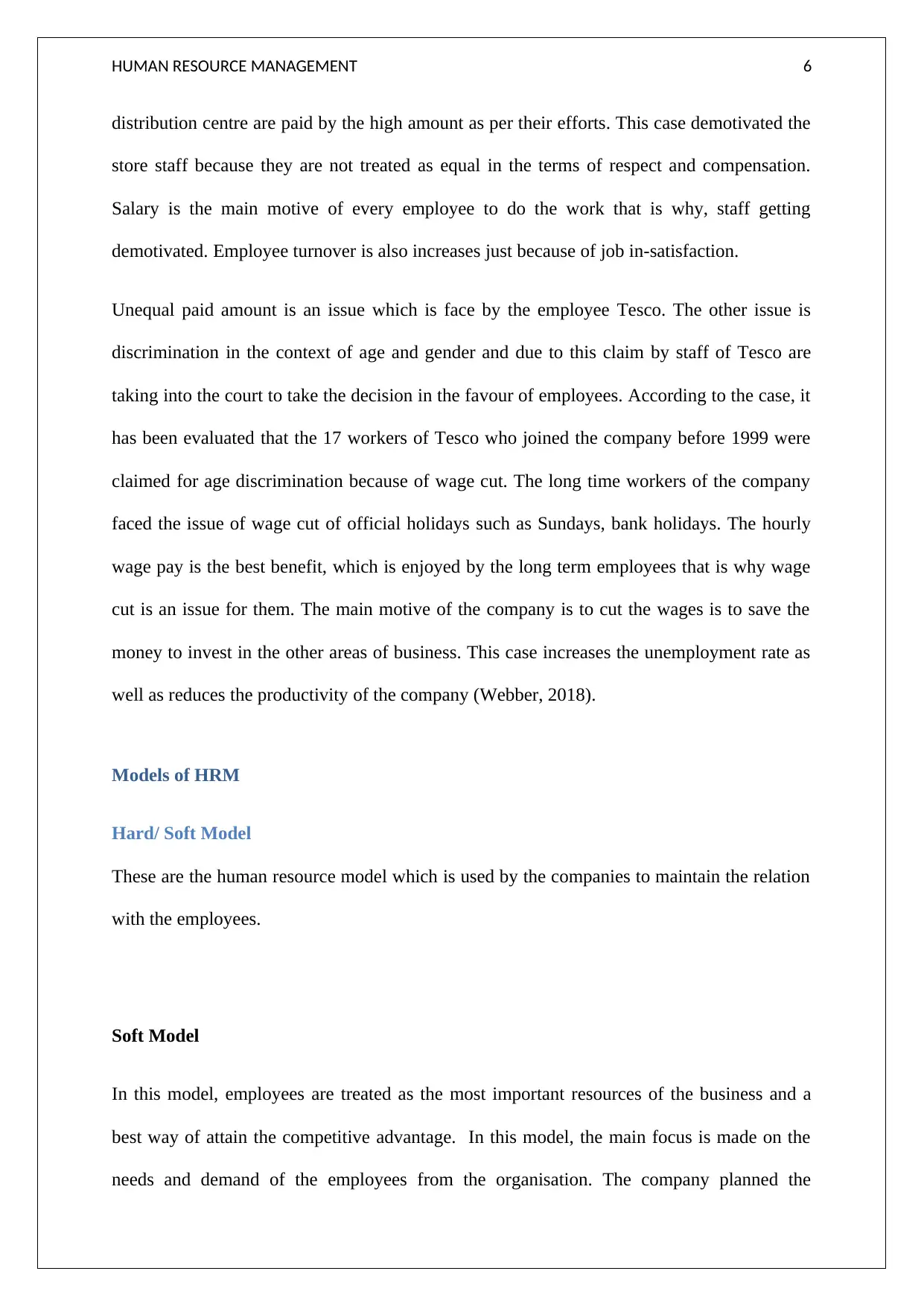
HUMAN RESOURCE MANAGEMENT 6
distribution centre are paid by the high amount as per their efforts. This case demotivated the
store staff because they are not treated as equal in the terms of respect and compensation.
Salary is the main motive of every employee to do the work that is why, staff getting
demotivated. Employee turnover is also increases just because of job in-satisfaction.
Unequal paid amount is an issue which is face by the employee Tesco. The other issue is
discrimination in the context of age and gender and due to this claim by staff of Tesco are
taking into the court to take the decision in the favour of employees. According to the case, it
has been evaluated that the 17 workers of Tesco who joined the company before 1999 were
claimed for age discrimination because of wage cut. The long time workers of the company
faced the issue of wage cut of official holidays such as Sundays, bank holidays. The hourly
wage pay is the best benefit, which is enjoyed by the long term employees that is why wage
cut is an issue for them. The main motive of the company is to cut the wages is to save the
money to invest in the other areas of business. This case increases the unemployment rate as
well as reduces the productivity of the company (Webber, 2018).
Models of HRM
Hard/ Soft Model
These are the human resource model which is used by the companies to maintain the relation
with the employees.
Soft Model
In this model, employees are treated as the most important resources of the business and a
best way of attain the competitive advantage. In this model, the main focus is made on the
needs and demand of the employees from the organisation. The company planned the
distribution centre are paid by the high amount as per their efforts. This case demotivated the
store staff because they are not treated as equal in the terms of respect and compensation.
Salary is the main motive of every employee to do the work that is why, staff getting
demotivated. Employee turnover is also increases just because of job in-satisfaction.
Unequal paid amount is an issue which is face by the employee Tesco. The other issue is
discrimination in the context of age and gender and due to this claim by staff of Tesco are
taking into the court to take the decision in the favour of employees. According to the case, it
has been evaluated that the 17 workers of Tesco who joined the company before 1999 were
claimed for age discrimination because of wage cut. The long time workers of the company
faced the issue of wage cut of official holidays such as Sundays, bank holidays. The hourly
wage pay is the best benefit, which is enjoyed by the long term employees that is why wage
cut is an issue for them. The main motive of the company is to cut the wages is to save the
money to invest in the other areas of business. This case increases the unemployment rate as
well as reduces the productivity of the company (Webber, 2018).
Models of HRM
Hard/ Soft Model
These are the human resource model which is used by the companies to maintain the relation
with the employees.
Soft Model
In this model, employees are treated as the most important resources of the business and a
best way of attain the competitive advantage. In this model, the main focus is made on the
needs and demand of the employees from the organisation. The company planned the
Paraphrase This Document
Need a fresh take? Get an instant paraphrase of this document with our AI Paraphraser
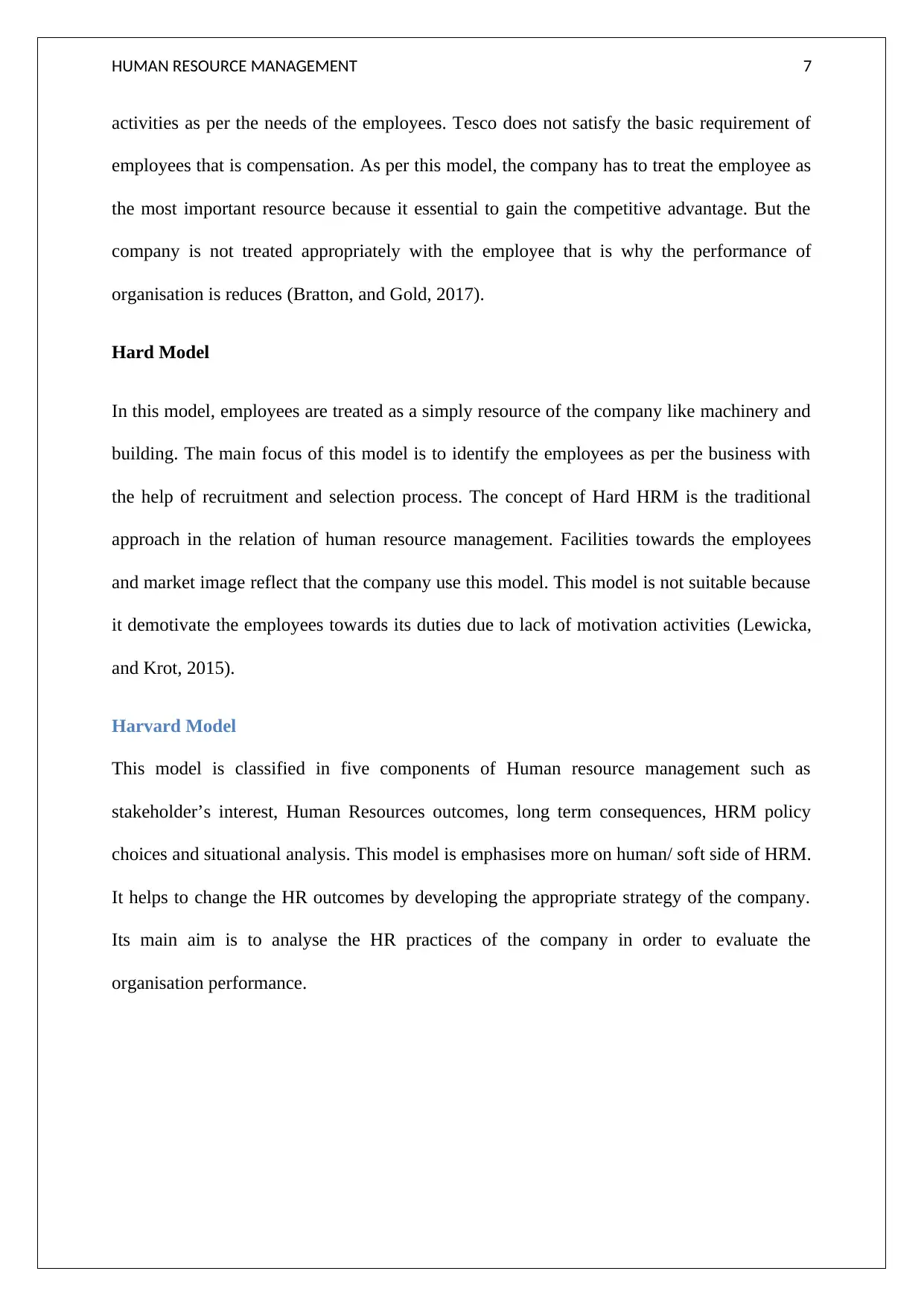
HUMAN RESOURCE MANAGEMENT 7
activities as per the needs of the employees. Tesco does not satisfy the basic requirement of
employees that is compensation. As per this model, the company has to treat the employee as
the most important resource because it essential to gain the competitive advantage. But the
company is not treated appropriately with the employee that is why the performance of
organisation is reduces (Bratton, and Gold, 2017).
Hard Model
In this model, employees are treated as a simply resource of the company like machinery and
building. The main focus of this model is to identify the employees as per the business with
the help of recruitment and selection process. The concept of Hard HRM is the traditional
approach in the relation of human resource management. Facilities towards the employees
and market image reflect that the company use this model. This model is not suitable because
it demotivate the employees towards its duties due to lack of motivation activities (Lewicka,
and Krot, 2015).
Harvard Model
This model is classified in five components of Human resource management such as
stakeholder’s interest, Human Resources outcomes, long term consequences, HRM policy
choices and situational analysis. This model is emphasises more on human/ soft side of HRM.
It helps to change the HR outcomes by developing the appropriate strategy of the company.
Its main aim is to analyse the HR practices of the company in order to evaluate the
organisation performance.
activities as per the needs of the employees. Tesco does not satisfy the basic requirement of
employees that is compensation. As per this model, the company has to treat the employee as
the most important resource because it essential to gain the competitive advantage. But the
company is not treated appropriately with the employee that is why the performance of
organisation is reduces (Bratton, and Gold, 2017).
Hard Model
In this model, employees are treated as a simply resource of the company like machinery and
building. The main focus of this model is to identify the employees as per the business with
the help of recruitment and selection process. The concept of Hard HRM is the traditional
approach in the relation of human resource management. Facilities towards the employees
and market image reflect that the company use this model. This model is not suitable because
it demotivate the employees towards its duties due to lack of motivation activities (Lewicka,
and Krot, 2015).
Harvard Model
This model is classified in five components of Human resource management such as
stakeholder’s interest, Human Resources outcomes, long term consequences, HRM policy
choices and situational analysis. This model is emphasises more on human/ soft side of HRM.
It helps to change the HR outcomes by developing the appropriate strategy of the company.
Its main aim is to analyse the HR practices of the company in order to evaluate the
organisation performance.
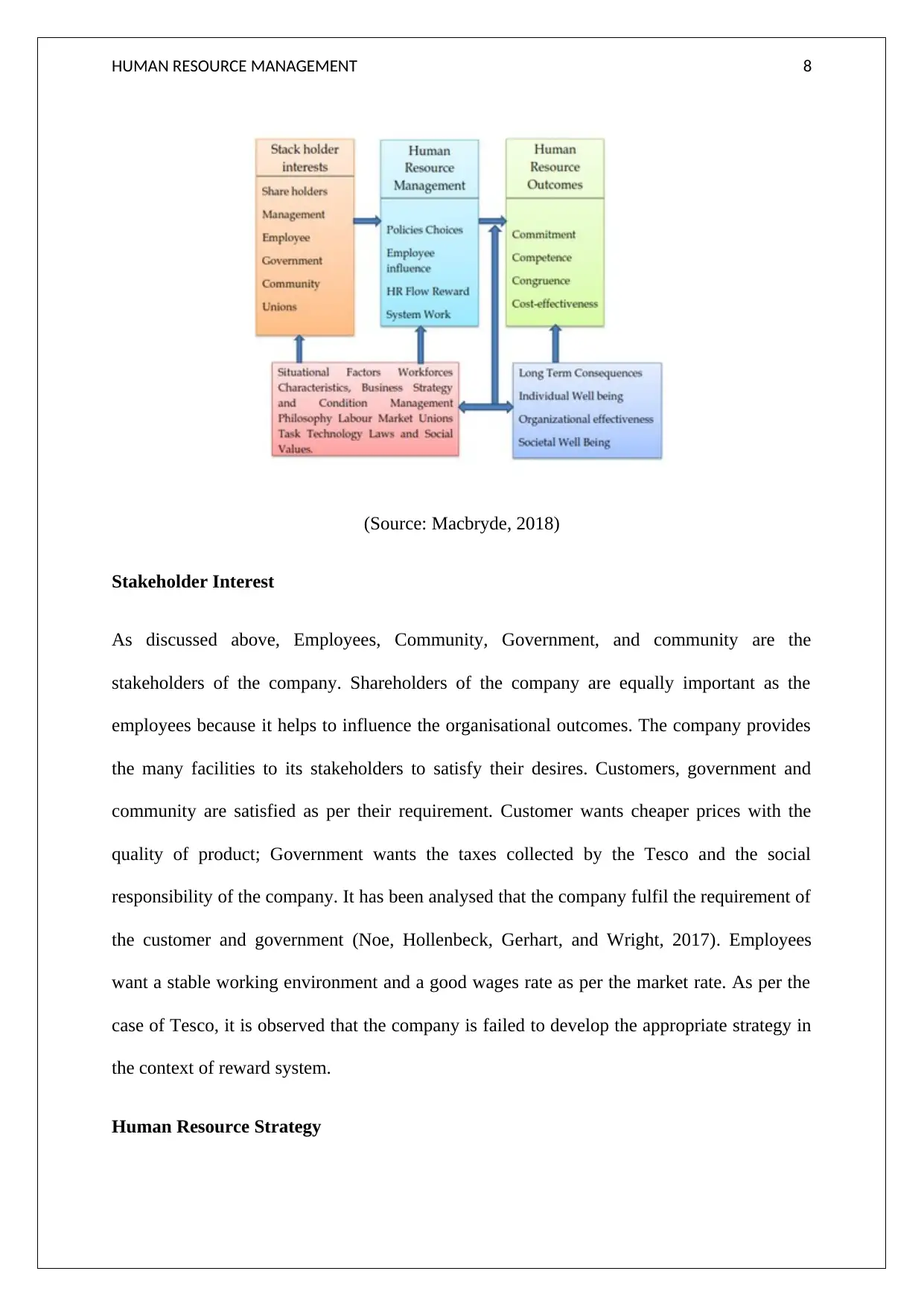
HUMAN RESOURCE MANAGEMENT 8
(Source: Macbryde, 2018)
Stakeholder Interest
As discussed above, Employees, Community, Government, and community are the
stakeholders of the company. Shareholders of the company are equally important as the
employees because it helps to influence the organisational outcomes. The company provides
the many facilities to its stakeholders to satisfy their desires. Customers, government and
community are satisfied as per their requirement. Customer wants cheaper prices with the
quality of product; Government wants the taxes collected by the Tesco and the social
responsibility of the company. It has been analysed that the company fulfil the requirement of
the customer and government (Noe, Hollenbeck, Gerhart, and Wright, 2017). Employees
want a stable working environment and a good wages rate as per the market rate. As per the
case of Tesco, it is observed that the company is failed to develop the appropriate strategy in
the context of reward system.
Human Resource Strategy
(Source: Macbryde, 2018)
Stakeholder Interest
As discussed above, Employees, Community, Government, and community are the
stakeholders of the company. Shareholders of the company are equally important as the
employees because it helps to influence the organisational outcomes. The company provides
the many facilities to its stakeholders to satisfy their desires. Customers, government and
community are satisfied as per their requirement. Customer wants cheaper prices with the
quality of product; Government wants the taxes collected by the Tesco and the social
responsibility of the company. It has been analysed that the company fulfil the requirement of
the customer and government (Noe, Hollenbeck, Gerhart, and Wright, 2017). Employees
want a stable working environment and a good wages rate as per the market rate. As per the
case of Tesco, it is observed that the company is failed to develop the appropriate strategy in
the context of reward system.
Human Resource Strategy
⊘ This is a preview!⊘
Do you want full access?
Subscribe today to unlock all pages.

Trusted by 1+ million students worldwide
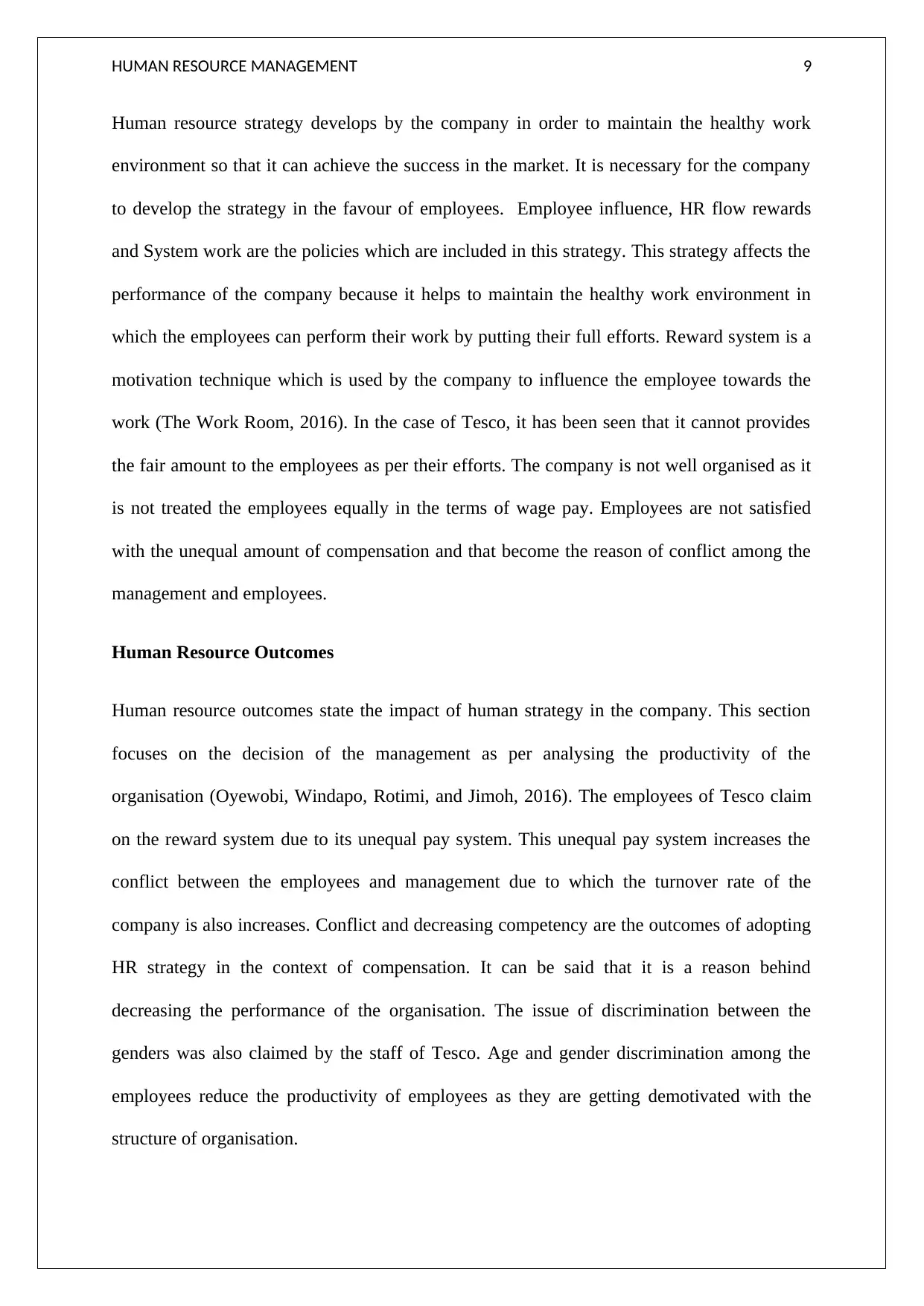
HUMAN RESOURCE MANAGEMENT 9
Human resource strategy develops by the company in order to maintain the healthy work
environment so that it can achieve the success in the market. It is necessary for the company
to develop the strategy in the favour of employees. Employee influence, HR flow rewards
and System work are the policies which are included in this strategy. This strategy affects the
performance of the company because it helps to maintain the healthy work environment in
which the employees can perform their work by putting their full efforts. Reward system is a
motivation technique which is used by the company to influence the employee towards the
work (The Work Room, 2016). In the case of Tesco, it has been seen that it cannot provides
the fair amount to the employees as per their efforts. The company is not well organised as it
is not treated the employees equally in the terms of wage pay. Employees are not satisfied
with the unequal amount of compensation and that become the reason of conflict among the
management and employees.
Human Resource Outcomes
Human resource outcomes state the impact of human strategy in the company. This section
focuses on the decision of the management as per analysing the productivity of the
organisation (Oyewobi, Windapo, Rotimi, and Jimoh, 2016). The employees of Tesco claim
on the reward system due to its unequal pay system. This unequal pay system increases the
conflict between the employees and management due to which the turnover rate of the
company is also increases. Conflict and decreasing competency are the outcomes of adopting
HR strategy in the context of compensation. It can be said that it is a reason behind
decreasing the performance of the organisation. The issue of discrimination between the
genders was also claimed by the staff of Tesco. Age and gender discrimination among the
employees reduce the productivity of employees as they are getting demotivated with the
structure of organisation.
Human resource strategy develops by the company in order to maintain the healthy work
environment so that it can achieve the success in the market. It is necessary for the company
to develop the strategy in the favour of employees. Employee influence, HR flow rewards
and System work are the policies which are included in this strategy. This strategy affects the
performance of the company because it helps to maintain the healthy work environment in
which the employees can perform their work by putting their full efforts. Reward system is a
motivation technique which is used by the company to influence the employee towards the
work (The Work Room, 2016). In the case of Tesco, it has been seen that it cannot provides
the fair amount to the employees as per their efforts. The company is not well organised as it
is not treated the employees equally in the terms of wage pay. Employees are not satisfied
with the unequal amount of compensation and that become the reason of conflict among the
management and employees.
Human Resource Outcomes
Human resource outcomes state the impact of human strategy in the company. This section
focuses on the decision of the management as per analysing the productivity of the
organisation (Oyewobi, Windapo, Rotimi, and Jimoh, 2016). The employees of Tesco claim
on the reward system due to its unequal pay system. This unequal pay system increases the
conflict between the employees and management due to which the turnover rate of the
company is also increases. Conflict and decreasing competency are the outcomes of adopting
HR strategy in the context of compensation. It can be said that it is a reason behind
decreasing the performance of the organisation. The issue of discrimination between the
genders was also claimed by the staff of Tesco. Age and gender discrimination among the
employees reduce the productivity of employees as they are getting demotivated with the
structure of organisation.
Paraphrase This Document
Need a fresh take? Get an instant paraphrase of this document with our AI Paraphraser
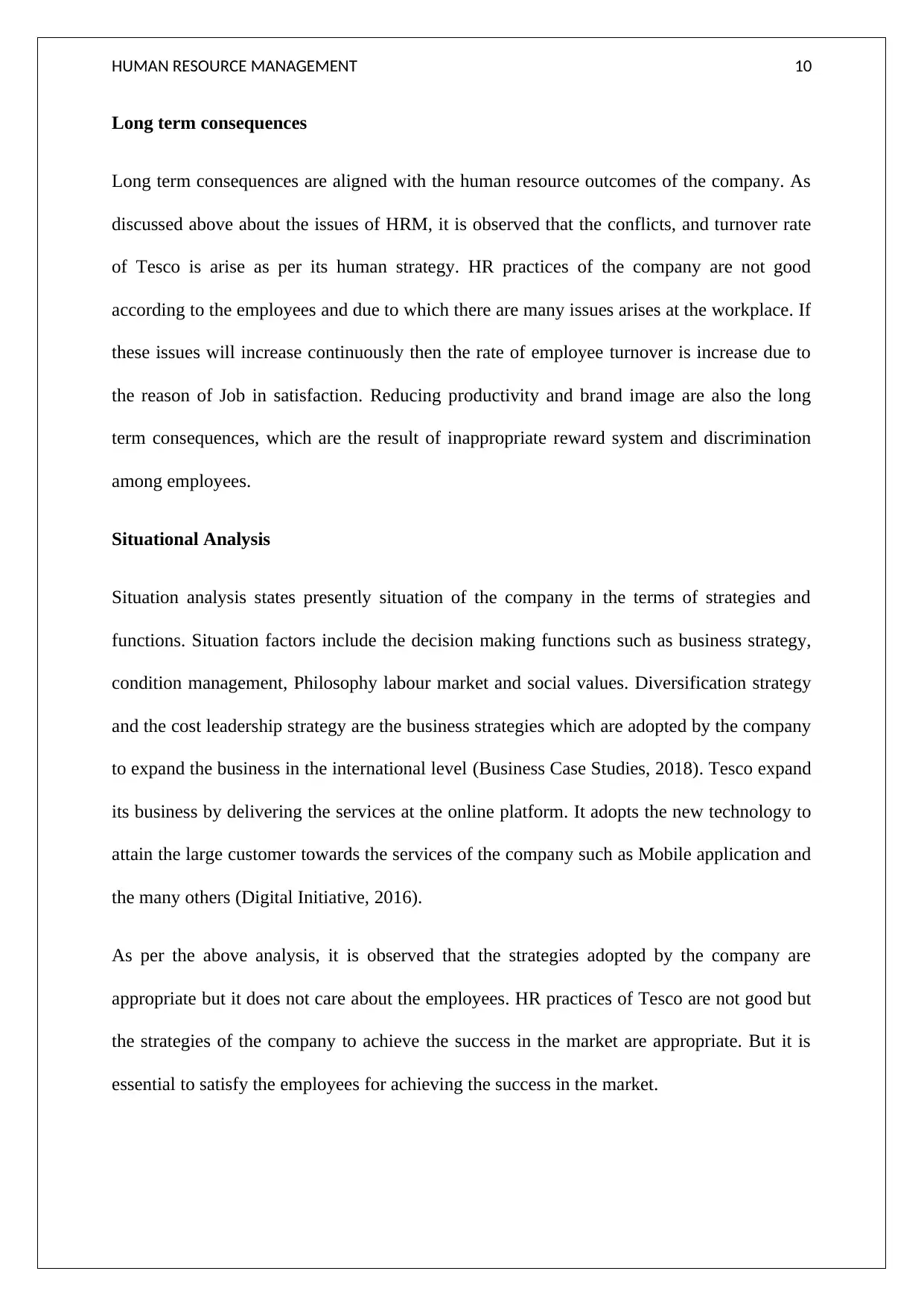
HUMAN RESOURCE MANAGEMENT 10
Long term consequences
Long term consequences are aligned with the human resource outcomes of the company. As
discussed above about the issues of HRM, it is observed that the conflicts, and turnover rate
of Tesco is arise as per its human strategy. HR practices of the company are not good
according to the employees and due to which there are many issues arises at the workplace. If
these issues will increase continuously then the rate of employee turnover is increase due to
the reason of Job in satisfaction. Reducing productivity and brand image are also the long
term consequences, which are the result of inappropriate reward system and discrimination
among employees.
Situational Analysis
Situation analysis states presently situation of the company in the terms of strategies and
functions. Situation factors include the decision making functions such as business strategy,
condition management, Philosophy labour market and social values. Diversification strategy
and the cost leadership strategy are the business strategies which are adopted by the company
to expand the business in the international level (Business Case Studies, 2018). Tesco expand
its business by delivering the services at the online platform. It adopts the new technology to
attain the large customer towards the services of the company such as Mobile application and
the many others (Digital Initiative, 2016).
As per the above analysis, it is observed that the strategies adopted by the company are
appropriate but it does not care about the employees. HR practices of Tesco are not good but
the strategies of the company to achieve the success in the market are appropriate. But it is
essential to satisfy the employees for achieving the success in the market.
Long term consequences
Long term consequences are aligned with the human resource outcomes of the company. As
discussed above about the issues of HRM, it is observed that the conflicts, and turnover rate
of Tesco is arise as per its human strategy. HR practices of the company are not good
according to the employees and due to which there are many issues arises at the workplace. If
these issues will increase continuously then the rate of employee turnover is increase due to
the reason of Job in satisfaction. Reducing productivity and brand image are also the long
term consequences, which are the result of inappropriate reward system and discrimination
among employees.
Situational Analysis
Situation analysis states presently situation of the company in the terms of strategies and
functions. Situation factors include the decision making functions such as business strategy,
condition management, Philosophy labour market and social values. Diversification strategy
and the cost leadership strategy are the business strategies which are adopted by the company
to expand the business in the international level (Business Case Studies, 2018). Tesco expand
its business by delivering the services at the online platform. It adopts the new technology to
attain the large customer towards the services of the company such as Mobile application and
the many others (Digital Initiative, 2016).
As per the above analysis, it is observed that the strategies adopted by the company are
appropriate but it does not care about the employees. HR practices of Tesco are not good but
the strategies of the company to achieve the success in the market are appropriate. But it is
essential to satisfy the employees for achieving the success in the market.
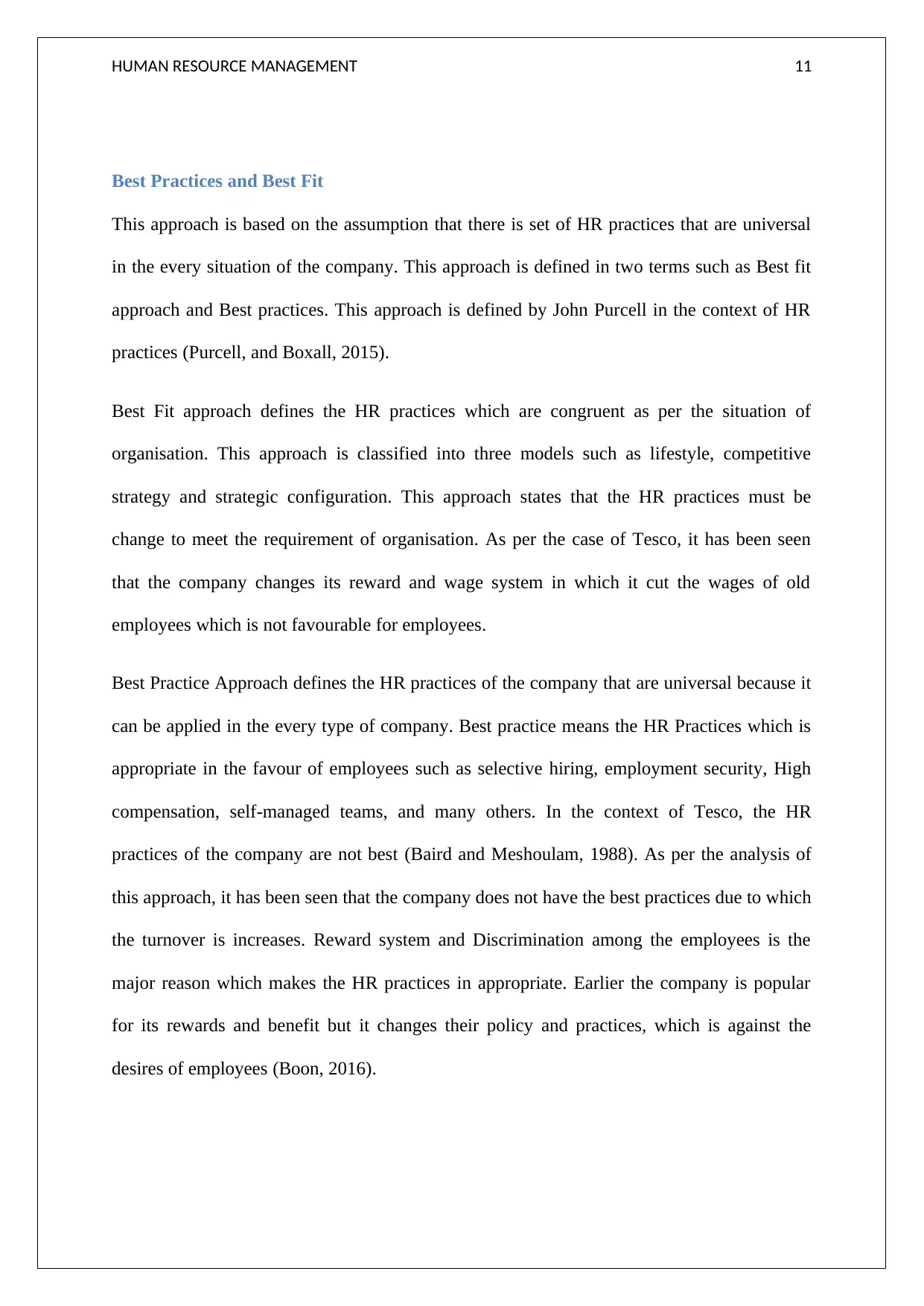
HUMAN RESOURCE MANAGEMENT 11
Best Practices and Best Fit
This approach is based on the assumption that there is set of HR practices that are universal
in the every situation of the company. This approach is defined in two terms such as Best fit
approach and Best practices. This approach is defined by John Purcell in the context of HR
practices (Purcell, and Boxall, 2015).
Best Fit approach defines the HR practices which are congruent as per the situation of
organisation. This approach is classified into three models such as lifestyle, competitive
strategy and strategic configuration. This approach states that the HR practices must be
change to meet the requirement of organisation. As per the case of Tesco, it has been seen
that the company changes its reward and wage system in which it cut the wages of old
employees which is not favourable for employees.
Best Practice Approach defines the HR practices of the company that are universal because it
can be applied in the every type of company. Best practice means the HR Practices which is
appropriate in the favour of employees such as selective hiring, employment security, High
compensation, self-managed teams, and many others. In the context of Tesco, the HR
practices of the company are not best (Baird and Meshoulam, 1988). As per the analysis of
this approach, it has been seen that the company does not have the best practices due to which
the turnover is increases. Reward system and Discrimination among the employees is the
major reason which makes the HR practices in appropriate. Earlier the company is popular
for its rewards and benefit but it changes their policy and practices, which is against the
desires of employees (Boon, 2016).
Best Practices and Best Fit
This approach is based on the assumption that there is set of HR practices that are universal
in the every situation of the company. This approach is defined in two terms such as Best fit
approach and Best practices. This approach is defined by John Purcell in the context of HR
practices (Purcell, and Boxall, 2015).
Best Fit approach defines the HR practices which are congruent as per the situation of
organisation. This approach is classified into three models such as lifestyle, competitive
strategy and strategic configuration. This approach states that the HR practices must be
change to meet the requirement of organisation. As per the case of Tesco, it has been seen
that the company changes its reward and wage system in which it cut the wages of old
employees which is not favourable for employees.
Best Practice Approach defines the HR practices of the company that are universal because it
can be applied in the every type of company. Best practice means the HR Practices which is
appropriate in the favour of employees such as selective hiring, employment security, High
compensation, self-managed teams, and many others. In the context of Tesco, the HR
practices of the company are not best (Baird and Meshoulam, 1988). As per the analysis of
this approach, it has been seen that the company does not have the best practices due to which
the turnover is increases. Reward system and Discrimination among the employees is the
major reason which makes the HR practices in appropriate. Earlier the company is popular
for its rewards and benefit but it changes their policy and practices, which is against the
desires of employees (Boon, 2016).
⊘ This is a preview!⊘
Do you want full access?
Subscribe today to unlock all pages.

Trusted by 1+ million students worldwide
1 out of 20
Related Documents
Your All-in-One AI-Powered Toolkit for Academic Success.
+13062052269
info@desklib.com
Available 24*7 on WhatsApp / Email
![[object Object]](/_next/static/media/star-bottom.7253800d.svg)
Unlock your academic potential
Copyright © 2020–2025 A2Z Services. All Rights Reserved. Developed and managed by ZUCOL.



